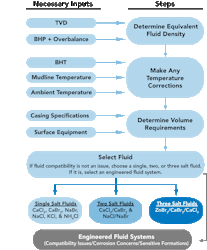The Planning Process
Design Rationale
The planning process steps are organized in such a way as to assist you in using basic pieces of information to develop a coherent project plan that encompasses all aspects of selecting the correct clear brine fluid, additives, and associated equipment. Many calculations have been formatted as tables or charts in order to help you quickly narrow your choices. There will also be circumstances that are unconventional or non-routine. In these cases, equations and appropriate units of measurement have been provided to facilitate the use of a handheld calculator.
The planning process steps are arranged to enable you to:
determine appropriate fluid density using true vertical depth (TVD), bottomhole pressure (BHP), and bottomhole temperature (BHT);
select the correct true crystallization temperature (TCT);
estimate the volume of clear brine fluid for the job;
select the proper clear brine fluid family (single, two, or three salt); or
where compatibility issues, corrosion concerns, or sensitive formations exist, select an engineered fluid system such as a MatchWell™ compatibility selected fluid system or a specialty fluid with a PayZone® formation protection additive package.
Figure 1 provides a conceptual flow of the fluid selection process in normal or non-high pressure, high temperature (HPHT) wells where the use of carbon steel tubing is planned. Required information or inputs are shown as arrows entering from the left. The flow steps run from top to bottom on the right.
FIGURE 1. Fluid Selection Process

Planning for Wells Requiring Corrosion Resistant Alloys
Given the potential for environmentally assisted cracking (EAC) in wells where corrosion resistant alloy (CRA) tubing will be used, especially in HPHT wells, the fluid selection process is different than that outlined above for traditional well completions. Rather than selecting the fluid at the end of the process, as is done in traditional completions, metallurgy and fluids should be selected concurrently for wells where a CRA will be used with a packer fluid. In these wells, it is important to take steps to decrease the probability of EAC by selecting the best combination of metallurgy and clear brine fluid for the specific well conditions. In an effort to better understand EAC, TETRA has participated in extensive testing and, through this testing, has developed the MatchWell fluid compatibility selector. This specialty software is designed to provide customer recommendation reports that identify compatible and cost effective metallurgy/fluid combinations.